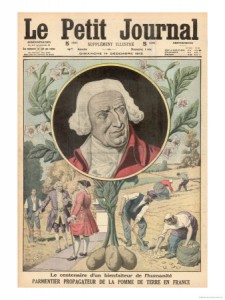 So, picking up on Monday’s tale of the potato’s rise to the status of staple food and, more specifically, the height of fashion: When France sent its army out against Frederick the Great’s in the Seven Year War, a 19-year-old pharmacist named Antoine-Augustin Parmentier signed up. He ended up locked in a Prussian prison, escaped, was recaptured, etc. until he served, by some accounts, a total of five stints in the cooler. Frederick, you’ll recall, had forced his starving Germanic masses to eat potatoes through the delicate wielding of the lash, and so Parmentier found himself eating nothing but during his stay.
So, picking up on Monday’s tale of the potato’s rise to the status of staple food and, more specifically, the height of fashion: When France sent its army out against Frederick the Great’s in the Seven Year War, a 19-year-old pharmacist named Antoine-Augustin Parmentier signed up. He ended up locked in a Prussian prison, escaped, was recaptured, etc. until he served, by some accounts, a total of five stints in the cooler. Frederick, you’ll recall, had forced his starving Germanic masses to eat potatoes through the delicate wielding of the lash, and so Parmentier found himself eating nothing but during his stay.
In spite of the fact that the potato was banned as human fodder in his home country because it was believed to cause leprosy, Parmentier did not, in fact, lose any digits. So when he made it home in 1763 and took the job of pharmacist at the Invalides Hospital, he tried to push the food. Alas, the Catholic Church ran the hospital, and we know how open they are to new and healthful ideas. Not even Parmentier’s win in a 1770 essay contest on “Foodstuffs Capable of Reducing the Calamities of Famine” changed their minds, nor the Paris Faculty of Medicine’s reclassification of the spud as legit food two years later. So Parementier searched his brain, scratched his long, cartoonish chin, and discovered his inner Charles Barnum. Continue reading
